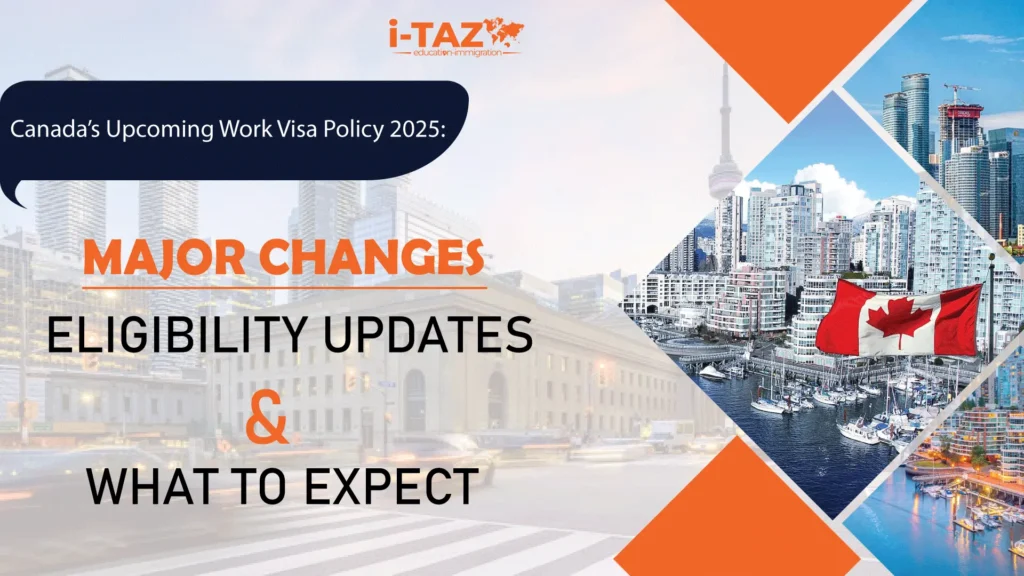Canada Upcoming Work Visa Policy has always been a very appealing destination for international students and professionals. The country boasts of a good education system, a good job market and good immigration laws. Which still continue to entice thousands of foreign workers and graduates annually.
The Canadian government is currently planning to make some major changes to its work visa and work permit policies. Which potentially offer new opportunities but also new responsibilities to those who apply. The Canada Work Permit Extension 2025 project seeks to streamline the process. And make it more transparent and geared towards the long-term labor market objectives in Canada.
Simplified Work Permit Renewal Process
The Canada Work Permit Extension 2025 has made its renewal simpler and digital. In addition to that, applicants can now renew their work permits completely online. Thereby saving on the paperwork and time of waiting.
In the Canada Upcoming Work Visa Policy system, employees would be requires to make sure. That they maintain employment with an employer registers under the Employer Compliance Regime. They should also preserve a clean immigration and employment record in Canada.
All renewals will require biometric validation, a valid job placement. And an active employment history to make sure that only legitimate and compliant workers are left to keep contributing to the Canadian economy.
Updated Eligibility Rules for 2025
The Canada Upcoming Work Visa Policy eligibility regulations add extra clarity. And order for the people who want their work permits to be extends. Moreover, relatives of the immigrants, including spouses and dependents. It can also extend their residence in Canada on the same working permit on the basis of meeting the requirements as establishes by the Immigration, Refugees and Citizenship Canada (IRCC). Applicants must:
-
- Be currently employs by an approves Canadian employer.
-
- Do not commit any violation of immigration or work laws in their bail.
-
- Support evidence of ongoing employment or a new valid job offer.
-
- Full biometric authentication during the renewal.
Canada’s New Work Visa Rules from November
First, Canada will introduce the significant changes to its international work visa and permit system. The changes will be includes in the Immigration Levels Plan 2025–2028. Which is aimed at balancing the increases foreign labor demand against the employment needs in the country.
The new plan presents a language proficiency requirement to the holders of Post-Graduate Work Permits (PGWP). Students who would seek to apply to the PGWP after November 2024 will be requires to prove language proficiency of CLB 7.
Minimum CLB 5 will be allowed for college graduates. Which will guarantee that everyone joining the Canadian labor market has excellent communication skills. And can easily adapt to the professional setting.
Focus on Skilled Professionals and Spouses
The IRCC has also tightens the requirements of the Spousal Open Work Permit (SOWP) program. Since 2025, SOWPs are mainly going to be offers to spouses of highly skills professionals, including engineers, executives, medical workers, lawyers, scientists, and professionals in high-demand fields.
This reform will guarantee that Canada remains focuses on skill-based immigration and improve the economic productivity of the country by involving qualifies families in the workforce.
Canada’s 2026–2028 Immigration Levels Plan
In November IRCC will also publish the formal 2026–2028 Immigration Levels Plan. Which will provide the future immigration goals and policies of Canada. The plan will give the employers and workers a clear vision of the direction that Canada will take in the next few years.
Although complete information is not discloses so far, judging by the government messages one can expect several major tendencies:
Permanent residency targets:
Canada will limit the permanent resident admissions to approximately 416,500 people by the year 2026. Which is in line with the reduction in the total targets that was made last year.
Increased Express Entry Admissions:
More positions will be found in Express Entry categories, particularly the ones making in-demand occupations, French-speaking entrants. As well as foreign nationals who already reside in Canada under a valid temporary status.
Better Provincial Nominee Program (PNP) Allocations:
Provinces such as British Columbia, Manitoba, Saskatchewan, Newfoundland and Labrador, and New Brunswick will get more PNP quotas to satisfy regional labor demands.
Regulated Growth of Temporary Residency:
The government should be trying to bring down the number of temporary residents to less than 5 percent of the total Canadian population. And strike a balance between population growth and employment sustainability.
A concentration on the Francophone immigration:
Canada will remain in favor of encouraging French-speaking immigration. It providing new opportunities and settlement services to candidates speaking French.
What These Changes Mean for International Students
To the international students studying in Canada, these reforms are not only a representation of an opportunity but also a challenge. The requirement of new language proficiency of the PGWP implies that students should give preference to English or French training at the beginning of their academic path.
On the brighter side, simplifies online applications and clearer eligibility criteria facilitate. Canadian graduates in their pursuit of employment after they have graduated. The ones that satisfy the new requirements will find it easy to succeed in the long term. Even possibly in the form of a transition to permanent residence under the Express Entry or PNP programs.
Impacts on Employers and the Job Market
The upcoming plan is likely to benefit the employers across Canada and particularly the western provinces. The provincial nominee programs will see more allocations and thus enable. Them to employ more international talent in areas like construction, healthcare, engineering, IT, and agriculture that are critical.
Nevertheless, this cut down in the number of temporary residents may be a challenge to those industries that are dependent on temporary or seasonal labor. Hospitality and agriculture companies could be forces to change their recruitment policy to match the new immigration restrictions.
Canada’s Commitment to a Balanced Immigration Strategy
The new policies of the Canadian government are the attempts to find the balance between the needs of the economy and the sustainable growth of immigration. A combination of establishing explicit regulations and increasing the chances of qualifies specialists will make Canada grow as a favorable and just place to work or study in the world.
The emergence of language prerequisites, the increasing periods of stay of families, and the digitization of work permit renewals are all signs of a contemporary, skills-based immigration model, which positively affects both immigrants and employers.
Conclusion
The future Canada Work Permit Extension 2025 and the bigger Immigration Levels Plan 2026-2028 is a new beginning for the immigration program in Canada. The reforms however, though they present a higher level of standards to the applicants, also provide fresh opportunities to skilled professionals, graduates and families in order to pursue a future in Canada.
International students, temporary employees, and employers are advised to be updated on these changes and plan before these changes. These new rules can be in your favor with proper guidance and at the right time; you will be able to have the same opportunities to grab the long-run opportunities in one of the most dynamic and inclusive countries in the world.


















